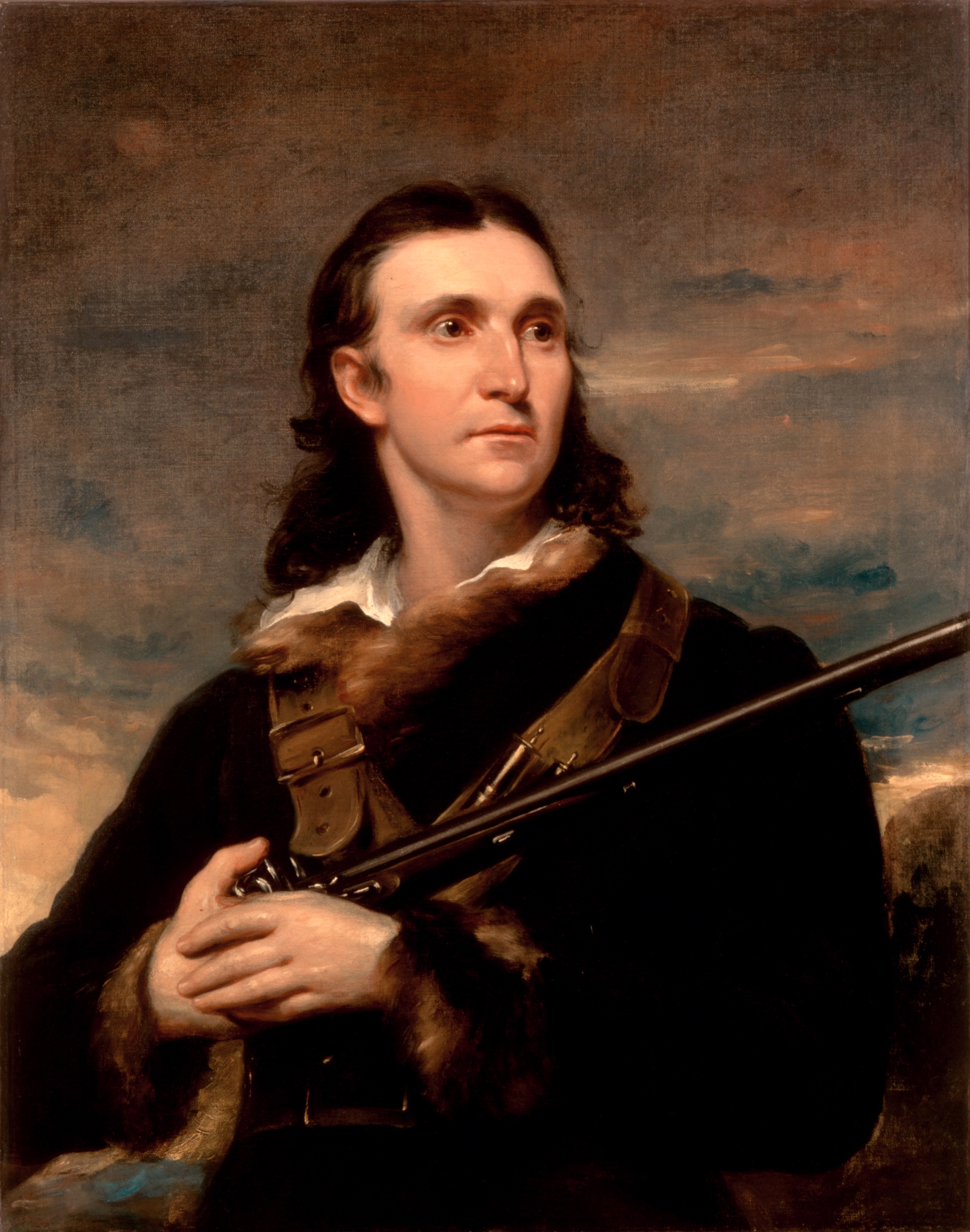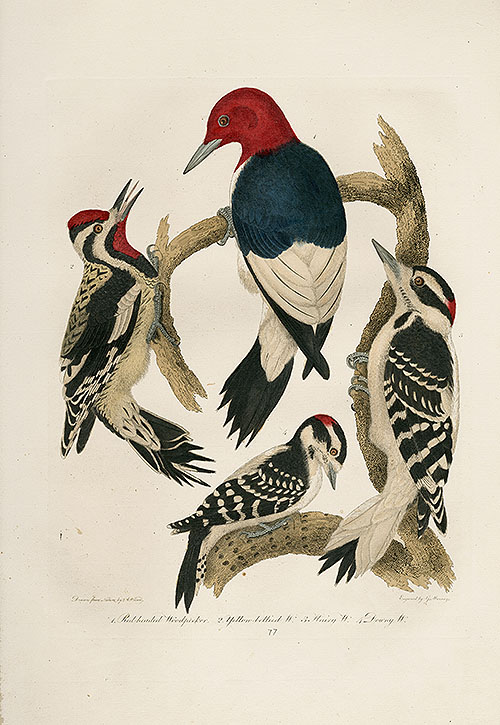So why pit them against one another? The main reason as stated above is that they were effectively striving for the same goal, to create a literary resource that showed artistically and verbally the diversity of bird life in their new American home. Another is that because of those similar interests, their legacies have taken decidedly different paths in the modern era and while both are still important figures, Audubon's name is more recognized and known than Wilson's. Why is that?
It's hardly surprising when you read into it. Audubon when compared to Wilson was simply the better salesman of his ideas, his art, and his dreams. Given his spotty business record and past troubles with having enough money for his family to survive, he had to be and with The Birds of America, he strove to provide the best resource available on the one love he had over all others: birds.
 |
| John James Audubon. Credit: Wikipedia |
It was in a general store on Louisville, Kentucky that Audubon would meet his contemporary and rival, Alexander Wilson. At many points in his life, Audubon would find it hard to support himself and his family. While his relationship with his wife would certainly have been tested during his long absences, their love for one another certainly shortened the distance and helped each other through their hard times. Despite this strong love and commitment, this didn't help with Audubon's business interests as he spent more of his time out looking for specimens than running those businesses. A few times he would even be imprisoned for outstanding debts that he'd incurred in his failed ventures.
 |
| Alexander Wilson. Credit: Wikipedia |
Upon his arrival in America, according to birding lore, the first bird he sighted and shot when he walked to Philadelphia was a Red-headed Woodpecker (Melanerpes erythrocephalus), a bird he had never seen before. After getting settled in America, he took odd jobs as a teacher and eventually landed a job editing an encyclopedia for a wealthy Philadelphian. It was while he was getting back on his feet that he became acquainted with William Bartram, a wealthy botanist and landowner who taught him the basics of bird identification at the time and looked over Wilson's notes and pictoral descriptions of the birds he found. He famously wrote to Bartram saying to his mentor "...to mark on the drawings, with a pencil, the names of each kind, as, except three or four, I do not know them." It was around this time that he learned to engrave his own drawings using copper plates so that he could, as much as possible, be the sole producer of his massive project. As he learned and grew more confident, the scientific community of Philadelphia began to take notice and soon he won the friendship of George Ord and other scientifically minded Philadelphians. This would put Wilson at an strong advantage to Audubon's attempts to publish his Birds of America several years later due to Ord's singular and practically blind hatred for Audubon and all he stood for or represented.
Upon his arrival in Louisville, Wilson solicited Audubon for a subscription to the first two volumes of his self produced American Ornithology. However, before the other could sign, Audubon's business partner, Ferdinand Rozier, deterred him noting that Audubon didn't have the capital to pay for such a subscription and besides, his paintings were far superior to this wandering salesman. Wilson was taken aback and chagrined at this sudden refusal, but was even more stunned when Audubon showed him his portfolio for a comparison. If you've never seen the different artists next to each other, it is quite striking.
 |
| Wilson's collection of woodpeckers |
 |
| Audubon's collection of woodpeckers |
Despite this apparent difference in talent however, Audubon gained no traction when it came to support for publishing his own book called The Birds of America. He was staunchly opposed by George Ord, who pointed out valid discrepancies in Audubon's work such as his copying some of the poses used by Wilson in American Ornithology and where he'd plagiarized notes from other volumes and attempted to pass it for his own observations, to outlandish and caustic remarks about Audubon's inclusion of plants in the backgrounds of his bird portraits and featuring birds in "unrealistic poses". This insurmountable opposition to potential publication forced Audubon to pursue subscribers overseas in England and France. It was here where his celebrity grew and far surpassed any that Wilson might have garnered in his life. Here he crafted himself in the image of the "American woodsman" and wore his shoulder length with a coonskin cap, buckskin jacket, and matching breeches. He looked and acted the part and through his interactions with the wealthy men of science, he made many friends. After nearly three years in Europe (a time where he deeply missed his wife and family and suffered periods of depression), he secured the help of the English engravers Robert Havell, Sr. and his son, Robert Havell, Jr. to create the plates needed. His Ornithological Biography, the accompanying text that described the species found in The Birds of America, was provided by the Scottish ornithologist William MacGillivray. When it was completed, the book was printed on elephant folio paper and a completed collection measured 2 feet wide x 3 feet tall! Audubon would later come out with a smaller version on octavo folio which was closer to the size of a modern encyclopedia.
After his success with Birds of America, Audubon with the help of his two sons, John Woodhouse Audubon and Victor Gifford Audubon, he set out to describe and paint the Viviparous Quadrapeds of North America. For those of us not versed in GRE-level language on a regular basis, he set out to document the mammals of North America, specifically the ones that walk on all fours (sorry Bigfoot) and give birth to live young. This effort was supported largely by his sons, as by this time, the elder Audubon's health was beginning to fail. He would manage to get along for few more years before dying on January 27th, 1851. His book on mammals was published posthumously the same year.
Wilson died a full 38 years beforehand on August 23rd, 1813 of dysentery. This rough end came as a result of his "nose to the grindstone" attitude and obsessive drive to find and document as many species as possible. Whereas Audubon had enjoyed fairly good health throughout his travels, Wilson suffered from poor health most of his life and this often prevented him from gathering the specimens necessary to complete his work. Fortunately, support from his Philadelphia patrons helped considerably and after he passed in 1813, Charles Lucien Bonaparte and George Ord each helped to complete the nine volume work. Despite all his work and research into discovering and describing the birds in his adoptive country, he is practically a footnote in ornithological history and greatly overshadowed by the artistic and celebrity appeal of Audubon. However, it can be argued that without Wilson's early work and meeting in Louisville, Audubon may not have been inspired to create his great work.
Regardless of modern speculation, these first contenders have all the hallmarks of a great starting contest. They match each other well in terms of their goals and interests, they achieved them with tremendous help from others, and were artists in their own right. In the next posting, I will be comparing their overall achievements and assigning points (positive and negative) to each. Who ever accumulates the most will advance to the next round.
No comments:
Post a Comment